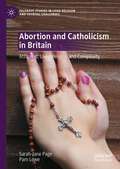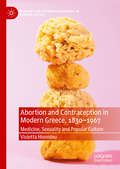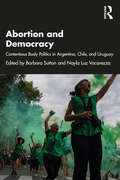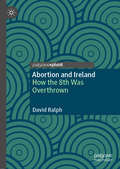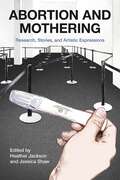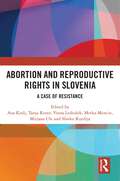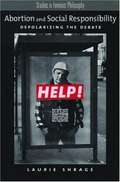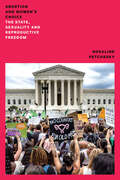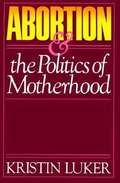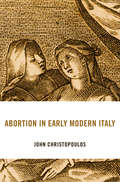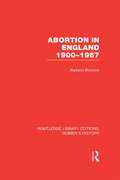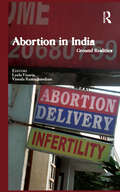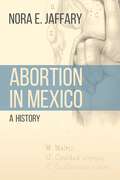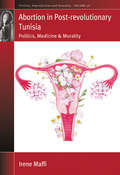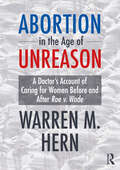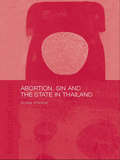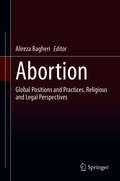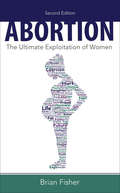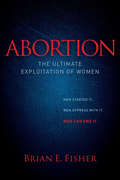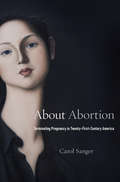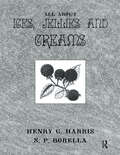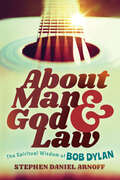- Table View
- List View
Abortion and Catholicism in Britain: Attitudes, Lived Religion and Complexity (Palgrave Studies in Lived Religion and Societal Challenges)
by Pam Lowe Sarah-Jane PageThis book details how British Catholic communities view abortion, highlighting the diversity of positions which often contrast with the official line of Catholic Church doctrine. The authors’ extensive qualitative investigation involving various Catholic constituents demonstrates the complex ways attitudes are formed. Based on interviews with priests, Catholic parishioners, anti-abortion activists and Catholics living in close proximity to activism, this book takes a lived religion approach to argue that attitudes and approaches to abortion are nuanced and contextual, with the Catholic concept of individual conscience playing a fundamental role in navigating abortion issues. Ultimately, this investigation helps to explore in much greater depth the increased liberalisation in attitudes among Catholics towards abortion, at a time when Catholic activism opposing abortion is growing, and therefore shines a light on the conflicts that are apparent at the heart of Catholic parishes. Thisbook will be of interest to scholars in Gender and Sexuality Studies, Sociology, Theology and Religious Studies.
Abortion and Contraception in Modern Greece, 1830-1967: Medicine, Sexuality and Popular Culture (Medicine and Biomedical Sciences in Modern History)
by Violetta HionidouThe book examines the history of abortion and contraception in Modern Greece from the time of its creation in the 1830s to 1967, soon after the Pill became available. It situates the history of abortion and contraception within the historiography of the fertility decline and the question of whether the decline was due to adjustment to changing social conditions or innovation of contraceptive methods. The study reveals that all methods had been in use for other purposes before they were employed as contraceptives. For example, Greek women were employing emmenagogues well before fertility was controlled; they did so in order to ‘put themselves right’ and to enhance their fertility. When they needed to control their fertility, they employed abortifacients, some of which were also emmenagogues, while others had been used as expellants in earlier times. Curettage was also employed since the late nineteenth century as a cure for sterility; once couples desired to control their fertility curettage was employed to procure abortion. Thus couples did not need to innovate but rather had to repurpose old methods and materials to new birth control methods. Furthermore, the role of physicians was found to have been central in advising and encouraging the use of birth control for ‘health’ reasons, thus facilitating and speeding fertility decline in Greece. All this occurred against the backdrop of a state and a church that were at times neutral and at other times disapproving of fertility control.
Abortion and Democracy: Contentious Body Politics in Argentina, Chile, and Uruguay
by Barbara SuttonAbortion and Democracy offers critical analyses of abortion politics in Latin America’s Southern Cone, with lessons and insights of wider significance. Drawing on the region’s recent history of military dictatorship and democratic transition, this edited volume explores how abortion rights demands fit with current democratic agendas. With a focus on Argentina, Chile, and Uruguay, the book’s contributors delve into the complex reality of abortion through the examination of the discourses, strategies, successes, and challenges of abortion rights movements. Assembling a multiplicity of voices and experiences, the contributions illuminate key dimensions of abortion rights struggles: health aspects, litigation efforts, legislative debates, party politics, digital strategies, grassroots mobilization, coalition-building, affective and artistic components, and movement-countermovement dynamics. The book takes an approach that is sensitive to social inequalities and to the transnational aspects of abortion rights struggles in each country. It bridges different scales of analysis, from abortion experiences at the micro level of the clinic or the home to the macro sociopolitical and cultural forces that shape individual lives. This is an important intervention suitable for students and scholars of abortion politics, democracy in Latin America, gender and sexuality, and women’s rights.
Abortion and Ireland: How the 8th Was Overthrown
by David RalphThis book asks the crucial question of how it came to pass that on the 25 May 2018, the Irish electorate voted by a landslide in favour of changing its abortion legislation that, for the previous thirty-five years, had been one of the most restrictive regimes in Europe. The author shows how, alongside traditional campaigning tactics such as street demonstrations, door-to-door canvassing, and the distribution of pro-choice merchandise and information leaflets, a key strategy of pro-choice advocacy groups was to encourage first-person abortion story-sharing by women in their efforts to repeal the Eighth Amendment, which had effectively banned abortion provision in the country. The book argues that a normalizing of abortion talk took place in the lead-up to the referendum, with women speaking publicly in unprecedented numbers about their abortion histories. These women storytellers were mirroring certain pro-choice movements in other contexts, where a new ‘sound it loud, say it proud’ narrative around abortion experiences has emerged as a central contemporary strategy for destigmatizing abortion discourse.Students and scholars across a range of disciplines, including law, gender studies, sociology, and human geography, will find this book of interest.
Abortion and Mothering: Research, Stories, and Artistic Expressions
by Heather Jackson;Jessica ShawAbortion and Mothering: Research, Stories, and Artistic Expressions is a collection of academic research, personal narratives, and art that comments on different perspectives on abortion and mothering. Scholarly research is balanced with voices and experiences from outside of academia, through the inclusion of personal narratives, poetry, and art. The collection is rooted in the idea that there are not 'women who have abortions' and 'women who have babies,' but that they are the same women at different points in their lives. By considering the intersection of abortion and mothering, and the liminal spaces in between, the reader is challenged to explore some of the culturally and socially constructed complexities that surround the decisions that people make about to their reproductive lives.
Abortion and Reproductive Rights in Slovenia: A Case of Resistance
by Ana Kralj Tanja Rener Vesna Leskošek Metka Mencin Mirjana Ule Slavko KurdijaAbortion and Reproductive Rights in Slovenia: A Case of Resistance provides a detailed and in-depth analysis of the situation of sexual and reproductive rights in Slovenia. This important intervention comes at a time when sexual and reproductive rights in Slovenia and around the world are assailed by populist and neoconservative discourses. The authors provide a detailed account of the history of the struggle for reproductive rights, particularly the struggles for access to safe abortion, insights based on interviews with fellow activists and an analysis of Slovenian public opinion on abortion in a temporal and comparative perspective. The scholar-activist authors put the issue of sexual and reproductive rights at the forefront of the social, political and scientific agenda in the name of collectivity and solidarity, reinforcing the potential apparent within civil society and social movements. This work will be of interest to researchers and activists with an interest in gender and reproductive rights in contemporary Europe.
Abortion and Social Responsibility: Depolarizing the Debate
by Laurie ShrageShrage argues that Roe v Wade's regulatory scheme of a six-month time span for abortion on demand polarized the public and obscured alternatives with potentially broader support. She explores the origins of that scheme, then defends an alternate one--with a time span shorter than 6 months for non-therapeutic abortions--that could win broad support needed to make legal abortion services available to all women.
Abortion and Woman's Choice: The State, Sexuality and Reproductive Freedom
by Rosalind Pollack Petchesky&“The best book I have read on the politics of reproduction. It raises complex theoretical and strategic questions, in a clear and accessible way, and represents an important breakthrough in feminist thinking.&”– Leslie Doyal, author of What Makes Women SickThis prize-winning study is the definitive work on the politics of abortion and fertility. Rosalind Pollack Petchesky provides overwhelming evidence against the anti-abortion forces and in the process takes up issues of teenage sexuality, the politics of eugenics, and women&’s relationship to medical technology. The book&’s continuing relevance is a tribute to the author and a sad indictment of contemporary politics.
Abortion and the Politics of Motherhood
by Kristin LukerKristin Luker examines the issues, people, and beliefs on both sides of the abortion conflict and draws data from twenty years of public documents and newspaper accounts, as well as over two hundred interviews with both pro-life and pro-choice activists.
Abortion and the Private Practice of Medicine
by Jonathan B. ImberOriginally published in 1986, Abortion and the Private Practice of Medicine was the first book to look at abortion from the perspective of physicians in private practice. Jonathan B. Imber spent two years observing and interviewing all twenty-six of the obstetrician-gynecologists in “Daleton,” a city that did not have an abortion clinic. The decision as to whether, when, and how to perform abortions was therefore essentially up to the individual doctor. Imber begins the volume with a historical survey of medical views on abortion and the medical profession’s response to the legalization of abortion in the United States. Quoting extensively from his interviews, he looks at various characteristics of doctors that may affect their professional opinion on abortion: their age, gender, religious background, and length of residence in the community; the nature of their training and prior experience; and the setting of the practice (whether group or solo). Imber found that the physicians’ reasons for agreeing or refusing to perform abortions revealed considerable differences of opinion about how they construe their responsibilities.
Abortion in Early Modern Italy (I Tatti studies in Italian Renaissance history)
by John ChristopoulosA comprehensive history of abortion in Renaissance Italy.In this authoritative history, John Christopoulos provides a provocative and far-reaching account of abortion in sixteenth- and seventeenth-century Italy. Drawing on portraits of women who terminated—or were forced to terminate—pregnancies, he finds that Italians maintained a fundamental ambivalence about abortion, despite injunctions from civil and religious authorities. Italians from all levels of society sought, had, and participated in abortions. Early modern Italy was not an absolute anti-abortion culture, an exemplary Catholic society centered on the “traditional family.” Rather, Christopoulos shows, Italians held many views on abortion, and their responses to its practice varied.Bringing together medical, religious, and legal perspectives alongside a social and cultural history of sexuality, reproduction, and the family, Christopoulos offers a nuanced and convincing account of the meanings Italians ascribed to abortion and shows how prevailing ideas about the practice were spread, modified, and challenged. Christopoulos begins by introducing readers to prevailing medical ideas about abortion and women’s bodies, describing the widely available purgative medicines and surgeries that various healers and women themselves employed to terminate pregnancies. He also explores how these ideas and practices ran up against and shaped theology, medicine, and law. Catholic understanding of abortion was changing amid religious, legal, and scientific debates concerning the nature of human life, women’s bodies, and sexual politics. Christopoulos examines how ecclesiastical, secular, and medical authorities sought to regulate abortion, and how tribunals investigated and punished its procurers—or didn’t, even when they could have.
Abortion in England 1900-1967 (Routledge Library Editions: Women's History)
by Barbara BrookesOver the decades from 1900 to 1967 abortion was transformed from an important female-centred form of fertility control into a medical event, closely monitored by the State. This transition, the author argues here, took place against a background of debate over fertility control and its implications for women’s maternal role. The book, originally published in 1988, suggests that the inter-war years saw a crucial mapping of boundaries in the debates over abortion. The distinction between methods of fertility control used before and after conception was more sharply drawn. The abortion law was difficult to enforce and in 1936 the Abortion Law Reform Association was founded by feminists to call for safe legal abortion as a woman’s right. Resort to criminal abortion continued in the post-war years and the number of therapeutic abortions also began to increase. The medical profession’s attempt to create a distinction between worthy medical and spurious social reasons for fertility control gave way in the face of women’s demands for safe and effective means to plan when and if they would have children. After a hard-fought battle, the abortion law was reformed in 1967. The abortion decision, however, remained firmly in the hands of the medical profession.
Abortion in India: Ground Realities
by Leela VisariaIndia was a pioneer in legalizing induced abortion, or Medical Termination of Pregnancy (MTP) in 1971. Yet, after three decades, morbidity and mortality due to unsafe abortion remain a serious problem. There is little public debate on the issue despite several national campaigns on safe motherhood. Instead, discussion on abortion has mainly centred around declining sex ratio, sex-selective abortion, and the proliferation of abortion clinics in urban areas. Adding to the problem is that abortion continues to be a sensitive, private matter, often with ethical/moral/religious connotations that sets it apart from other reproductive health-seeking behaviour.This book fills a gap in our understanding of the ground realities with respect to induced abortion in India to create an evidence-based body of knowledge. Using both quantitative and qualitative research methods, the case studies show why and under what circumstances women seek abortion and the quality of services available to them. They also explore inter-generational differences in attitudes and practices, the perceptions and selection of providers, female-selective abortion, and informal abortion practitioners. Among other issues, the contributors show that strong preference for sons, availability of modern techniques for diagnostic tests, widespread acceptance of the small family norm, and heavy reliance on female sterilisation as the primary method of contraception lead women to abort unwanted pregnancies.A book that goes beyond the smokescreen of data and regulations to unravel the human story behind elective abortion, it will be of interest to those studying health, public policy, and gender, apart from the general reader.
Abortion in Mexico: A History (Engendering Latin America)
by Nora E. JaffaryAbortion in Mexico: A History concisely examines the long history of abortion from the early postcontact period through the present day in Mexico by studying the law, criminal and ecclesiastical trials, medical texts, newspapers, and other popular publications. Nora E. Jaffary draws on courts&’ and medical practitioners&’ handling of birth termination to advance two central arguments. First, Jaffary contends, the social, legal, and judicial condemnation of abortion should be understood more as an aberration than the norm in Mexico, as legal conditions and long periods of Mexican history indicate that the law, courts, the medical profession, and everyday Mexicans tolerated the practice. Second, the historical framework of abortion differed greatly from its present representation. The language of fetal personhood and the notion of the inherent value of human life were not central elements of the conceptualization of abortion until the late twentieth century. Until then, the regulation of abortion derived exclusively out of concerns for pregnant people themselves, specifically about their embodiment of sexual honor. In Abortion in Mexico Jaffary presents the first longue durée examination of this history from a variety of locations in Mexico, providing a concise yet comprehensive overview of the practice of abortion and informing readers of just how much the debate has evolved.
Abortion in Post-revolutionary Tunisia: Politics, Medicine and Morality (Fertility, Reproduction and Sexuality: Social and Cultural Perspectives #46)
by Irene MaffiAfter the revolution of 2011, the electoral victory of the Islamist party ‘Ennahdha’ allowed previously silenced religious and conservative ideas about women’s right to abortion to be expressed. This also allowed healthcare providers in the public sector to refuse abortion and contraceptive care. This book explores the changes and continuity in the local discourses and practices related to the body, sexuality, reproduction and gender relationships. It also investigates how the bureaucratic apparatus of government healthcare facilities affects the complex moral world of clinicians and patients.
Abortion in the Age of Unreason: A Doctor's Account of Caring for Women Before and After Roe v. Wade
by Warren M. HernThis vivid account by a nationally prominent doctor reports the daily challenges of offering and receiving abortion services in a volatile political and social atmosphere. In stories from the front lines – from protecting patients and staff from protesters’ attacks to the dangers to women of restricted access to abortion services, and the pertinent findings of his remote research in Latin America, Hern’s book is strikingly detailed just as it exposes the needs of women and the U. S. national interest. Dr. Hern – an abortion specialist, researcher, scholar, and highly visible public advocate –shows how abortion saves women’s lives given the many risks that arise during pregnancy – remarkably more than most people realize. He points to political and national solutions to reverse a reawakened crisis that now threatens democracy. Throughout the book, Dr. Hern shows how the current emergency was largely created by political actors who have exploited and distorted the abortion issue to increase and consolidate their power.A vital component of women’s health care, the crisis over abortion is not new. Yet the reversal of Roe v. Wade and the steady accumulation of power by America’s right wing has put the issue at a level of urgency and national prominence not seen since the days before legalization. Women’s need for safe abortion services will continue as the struggle to secure their rights intensifies. This book is about that struggle during what has evolved, over the last 50 years, to an Age of Unreason.
Abortion, Sin and the State in Thailand (ASAA Women in Asia Series)
by Andrea WhittakerThis book discusses abortion in a non-Western, non-Christian context - in Thailand, where over 300,000 illegal abortions are performed each year by a variety of methods. The book, based on extensive original research in the field, examines a wide range of issues, including stories of the real-life dilemmas facing women, popular representations of abortion in the media, the history of the debate in Thailand and its links to politics. Overall, the work highlights the voices of women and their subjective experiences and perceptions of abortion, and places these 'women's stories' in an analysis of broader socio-political gender and power relations that structure sexuality and women's reproductive health decisions.
Abortion: Global Positions and Practices, Religious and Legal Perspectives
by Alireza BagheriRather than providing a global solution to the problem of abortion —to abort or not to abort—this volume sheds light on different but equally critical dimensions of abortion in global debate and practice. The aim is to elaborate on different value systems and policies in order to empower individuals to make well-informed decisions about abortion guided by moral reflection. The twenty one chapters of this volume are written by distinguished scholars in each of the religious and non-religious schools of thought, offering an exhaustive survey of the differing religious and legal views on abortion within the international community. The contributors present authoritative discussions in favor of or against abortion based on their perspectives and practices. As a result, the content of this book provides a foundational platform for better understanding, meaningful dialogue, and tolerance on a social issue which has divided individuals, philosophers, theologians, policy makers, and legislators within and across societies for centuries.
Abortion: Our Bodies, Their Lies, and the Truths We Use to Win
by Jessica ValentiNEW YORK TIMES BESTSELLER • In a stirring and succinct examination of post-Roe America, &“one of the most successful and visible feminists of her generation&” (Washington Post) takes on what&’s become the country&’s most resonant political issue. In her most urgent book yet, New York Times bestselling author Jessica Valenti shines a light on the conservative assault on women&’s freedom, cutting through the misinformation and overwhelm to inform, engage, and enrage. From the attacks Americans know about to the ones anti-abortion lawmakers and groups are trying to hide, Valenti details the tactics and horrors that she&’s been painstakingly tracking in her acclaimed newsletter, Abortion, Every Day. Abortion gives voice to women&’s frustration and outrage in a moment when they&’re fed up with being talked over and diminished. And in an election year when abortion is dominating the national conversation, Valenti provides the language, facts, and context readers need to feel confident when talking about the attacks on their bodies and freedom. Abortion is a handbook for the overwhelming majority of Americans who support abortion rights, whether they&’re seasoned activists or those just starting to learn. With the wit, expertise, and blunt moral clarity that&’s made her writing popular for decades, Valenti offers an essential manifesto in an urgent moment.
Abortion: The Ultimate Exploitation of Women
by Brian FisherThe author of Deliver Us from Abortion presents a five-point plan for men to put an end to abortion in America for women, men, and family.Do men have a stake in the abortion debate? Modern culture says no but author Brian Fisher shows why men are very much an interested party. Men led the campaign to legalize abortion—harming and exploiting women in the process. Now, he says, men must lead the effort to end the exploitation by ending abortion. And he presents a plan to do so. This revised and expanded second edition presents a more complete picture of how men target and exploit women globally, how this oppression is deeply connected to abortion, and how men can be, are, and should be a part of the solution.
Abortion: The Ultimate Exploitation of Women (Morgan James Faith)
by Brian E. FisherAbortion: The Ultimate Exploitation of Women unwinds the cultural myth that abortion empowers women. Not only are men responsible for promoting and legalizing abortion in America, they are the key beneficiaries. Using historical facts, medical research, and emotional personal stories, Fisher provides overwhelming evidence that abortion undermines women’s rights, victimizes women, children, and men, and is eroding the very fabric of our society.
About Abortion: Terminating Pregnancy in Twenty-First Century America
by Carol SangerNew medical technologies, women’s willingness to talk online and off, and tighter judicial reins on state legislatures are shaking up the practice of abortion. As talk becomes more transparent, Carol Sanger writes, women’s decisions about whether to become mothers will be treated more like those of other adults making significant personal choices.
About Face: Performing Race in Fashion and Theater
by Dorinne KondoFrom the runways of Paris to the casting controversies over BMiss Saigon, from a local demonstration at the Claremont Colleges in California to the gender-blending of BM. Butterfly, BAbout Face examines representations of Asia and their reverberations in both Asia and Asian American lives. Japanese high fashion and Asian American theater become points of entry into the politics of pleasure, the performance of racial identities, and the possibility of political intervention in commodity capitalism. Based on Kondo's fieldwork, this interdisciplinary work brings together essays, interviews with designer Rei Kawakubo of Comme des Garcons and playwright David Henry Hwang, and "personal" vignettes in its exploration of counter-Orientalisms.
About Ices Jellies & Creams
by HarrisFirst published in 2005. Routledge is an imprint of Taylor & Francis, an informa company.
About Man and God and Law: The Spiritual Wisdom of Bob Dylan
by Stephen Daniel ArnoffAbout Man and God and Law is the story of how Bob Dylan sparked a revolution of the spirit and why it matters today.Many of our assumptions about empathy, sensual pleasure, and the essence of work, community, country, race, and the divine have germinated in Bob Dylan’s need to know what’s blowing in the wind and how it feels. Tracing his work and vision through themes that have shaped religious and cultural history for millennia, Stephen Daniel Arnoff uncovers how Bob Dylan has re-enchanted ancient questions of meaning and purpose throughout popular culture, inspiring a pantheon of prophetic musicians along the way. This field guide to Dylan's spiritual wisdom aims to make good on the promise that if we look closely enough at his body of work—precisely at a moment when the world we thought we knew seems like uncharted territory—we can open up our eyes to see not only where we really are, but where we need to go.
